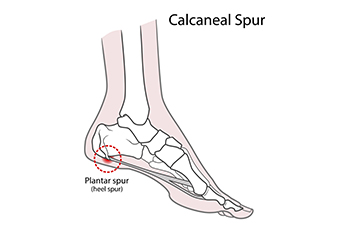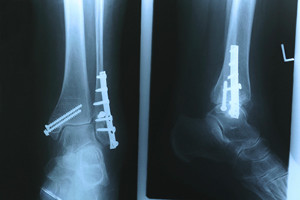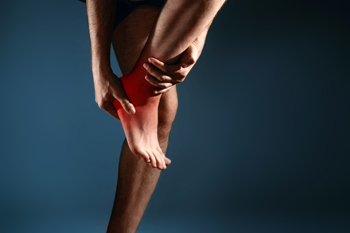3885 S. Decatur Blvd Suite #1080
Las Vegas, NV 89103

A heel spur is a common foot condition that is often discussed in the context of heel pain and discomfort. Despite their reputation, they are not actually sharp, pointy growths, as the term may imply. Instead, heel spurs are calcium deposits that form on the underside of the heel bone. These deposits often develop over an extended period of time due to chronic inflammation or stress on the plantar fascia, the band of tissue that connects the heel to the toes. The primary characteristic of heel spurs is the accompanying pain. This discomfort is often described as a sharp, stabbing sensation, particularly with the first steps in the morning or after prolonged periods of rest. It is important to note that not everyone with heel spurs experiences pain, as many people have them without any symptoms. The causes of heel spurs are diverse, with factors such as obesity, gait abnormalities, or wearing inadequate footwear contributing significantly. Heel spurs are a condition that is often linked to heel pain, but they are generally not the sole cause. If you are experiencing persistent heel pain, it is suggested that you consult a podiatrist, who can accurately diagnose and treat heel spurs if they are the culprit.
Heel spurs can be incredibly painful and sometimes may make you unable to participate in physical activities. To get medical care for your heel spurs, contact Loren Hansen, DPM from Ankle & Foot Medical Center. Our doctor will do everything possible to treat your condition.
Heels Spurs
Heel spurs are formed by calcium deposits on the back of the foot where the heel is. This can also be caused by small fragments of bone breaking off one section of the foot, attaching onto the back of the foot. Heel spurs can also be bone growth on the back of the foot and may grow in the direction of the arch of the foot.
Older individuals usually suffer from heel spurs and pain sometimes intensifies with age. One of the main condition's spurs are related to is plantar fasciitis.
Pain
The pain associated with spurs is often because of weight placed on the feet. When someone is walking, their entire weight is concentrated on the feet. Bone spurs then have the tendency to affect other bones and tissues around the foot. As the pain continues, the feet will become tender and sensitive over time.
Treatments
There are many ways to treat heel spurs. If one is suffering from heel spurs in conjunction with pain, there are several methods for healing. Medication, surgery, and herbal care are some options.
If you have any questions feel free to contact our office located in Las Vegas, NV . We offer the latest in diagnostic and treatment technology to meet your needs.

Stress fractures are tiny, gradual bone cracks caused by overuse or repetitive activities, common in athletes. Unlike sudden regular fractures, they develop over time, often affecting the feet and lower limbs. Risk factors include excessive stress, hard surfaces, and rapid changes in exercise intensity. Other causes are weak muscles, joint issues, osteoporosis, medications, poor footwear, and vitamin deficiencies. Symptoms include localized pain, swelling, tenderness, and discomfort during high-impact activities. Diagnosis involves a physical assessment, potentially followed by an X-ray or MRI. Treatment includes rest, compression, training modification, and low-impact activities. Supportive footwear, custom foot orthotics, anti-inflammatories, and exercises can also help. Surgery may be needed in severe cases. Ignoring stress fractures can lead to complete fractures, non-healing, bone necrosis, and surgery. If you are experiencing foot or ankle pain, it is strongly suggested that you make an appointment with a podiatrist who can properly diagnose the issue and provide treatment options.
Activities where too much pressure is put on the feet can cause stress fractures. To learn more, contact Loren Hansen, DPM from Ankle & Foot Medical Center. Our doctor can provide the care you need to keep your pain free and on your feet.
Dealing with Stress Fractures of the Foot and Ankle
Stress fractures occur in the foot and ankle when muscles in these areas weaken from too much or too little use. The feet and ankles then lose support when walking or running from the impact of the ground. Since there is no protection, the bones receive the full impact of each step. Stress on the feet can cause cracks to form in the bones, thus creating stress fractures.
What Are Stress Fractures?
Stress fractures occur frequently in individuals whose daily activities cause great impact on the feet and ankles. Stress factors are most common among:
Symptoms
Pain from the fractures occur in the area of the fractures and can be constant or intermittent. It will often cause sharp or dull pain with swelling and tenderness. Engaging in any kind of activity which involves high impact will aggravate pain.
If you have any questions please feel free to contact our office located in Las Vegas, NV . We offer the newest diagnostic and treatment technologies for all your foot and ankle needs.

Morton's neuroma is a nerve condition in the feet, often causing discomfort and pain. The primary symptom is a sharp or burning pain typically felt between the third and fourth toes, but it can also extend to the ball of the foot. Individuals with Morton's neuroma may describe a sensation of having a pebble or lump inside their shoe. Additionally, many people experience numbness, tingling, or a feeling akin to standing on a fold in their sock. Pain tends to worsen with walking, wearing tight shoes, or putting pressure on the affected area. People may feel relief by removing their shoes or massaging their foot. These symptoms can be intermittent or chronic, affecting daily activities and quality of life. Recognizing these signs is essential for early intervention and appropriate management of Morton's neuroma. If you suspect you may have this condition, it is suggested that you seek medical advice from a podiatrist who can provide you with an accurate diagnosis and tailored treatment plan.
Morton’s neuroma is a very uncomfortable condition to live with. If you think you have Morton’s neuroma, contact Loren Hansen, DPM of Ankle & Foot Medical Center. Our doctor will attend to all of your foot care needs and answer any of your related questions.
Morton’s Neuroma
Morton's neuroma is a painful foot condition that commonly affects the areas between the second and third or third and fourth toe, although other areas of the foot are also susceptible. Morton’s neuroma is caused by an inflamed nerve in the foot that is being squeezed and aggravated by surrounding bones.
What Increases the Chances of Having Morton’s Neuroma?
Morton’s neuroma is a very treatable condition. Orthotics and shoe inserts can often be used to alleviate the pain on the forefront of the feet. In more severe cases, corticosteroids can also be prescribed. In order to figure out the best treatment for your neuroma, it’s recommended to seek the care of a podiatrist who can diagnose your condition and provide different treatment options.
If you have any questions, please feel free to contact our office located in Las Vegas, NV . We offer the newest diagnostic and treatment technologies for all your foot care needs.

When it comes to marathon running, a grueling 26.2-mile journey, selecting the ideal pair of running shoes can significantly affect your performance and overall foot health, as well as prevent injury. Here are some essential features to consider when choosing your marathon running shoes. Cushioning plays a vital role in marathon shoes. Select shoes with adequate midsole cushioning to absorb the shock generated by each stride. Arch support for proper foot alignment is essential to prevent overpronation or supination, either of which can lead to discomfort and potential injuries. Breathability is important, as running for extended periods can result in sweaty feet, which may lead to discomfort, infection, and even blisters. The weight of marathon shoes cannot be ignored. The lighter the shoe, the less fatigue your legs will experience over the long distance. Lastly, durability should not be underestimated. Marathon training and racing can put your shoes through significant wear and tear. To ensure your shoes last the distance, select pairs constructed from high-quality materials designed to withstand the rigors of marathon running. For additional help with selecting the right running shoes, it is suggested that you consult a podiatrist.
If you are a runner, wearing the right running shoe is essential. For more information, contact Loren Hansen, DPM from Ankle & Foot Medical Center. Our doctor can provide the care you need to keep you pain-free and on your feet.
Choosing the Right Running Shoe for Your Foot Type
To increase performance and avoid the risk of injury, it is important to choose the right running shoe based on your foot type. The general design of running shoes revolves around pronation, which is how the ankle rolls from outside to inside when the foot strikes the ground.
If you have any questions please feel free to contact our office located in Las Vegas, NV . We offer the newest diagnostic and treatment technologies for all your foot and ankle needs.

Heel pain is a common ailment that can be both uncomfortable and debilitating. To effectively address heel pain, it is important to understand its underlying causes, as they can vary widely. One prevalent culprit is plantar fasciitis, a condition marked by inflammation of the plantar fascia, a thick band of tissue that runs along the bottom of the foot. This condition often results from overuse, poor footwear choices, or excessive strain on the foot's arch. Achilles tendinitis is another leading cause of heel pain, stemming from inflammation of the Achilles tendon, located at the back of the heel. This condition can be triggered by intense physical activity, tight calf muscles, or inadequate warm-up routines. Heel spurs, bony growths on the heel bone, can also lead to discomfort, though they may not always be painful. Stress fractures, arthritis, nerve irritation, and obesity are additional factors that can contribute to heel pain. Wearing unsupportive shoes and making abrupt increases in physical activity levels can exacerbate these conditions. To effectively manage heel pain, it is essential to identify the specific cause through proper diagnosis. Treatment options may include rest, stretching exercises, orthotic devices, or, in some cases, medical interventions, depending on the severity and root cause of the pain. If you are experiencing heel pain, it is suggested that you visit a podiatrist who can diagnose the cause and offer a treatment plan that is right for you.
Many people suffer from bouts of heel pain. For more information, contact Loren Hansen, DPM of Ankle & Foot Medical Center. Our doctor can provide the care you need to keep you pain-free and on your feet.
Causes of Heel Pain
Heel pain is often associated with plantar fasciitis. The plantar fascia is a band of tissues that extends along the bottom of the foot. A rip or tear in this ligament can cause inflammation of the tissue.
Achilles tendonitis is another cause of heel pain. Inflammation of the Achilles tendon will cause pain from fractures and muscle tearing. Lack of flexibility is also another symptom.
Heel spurs are another cause of pain. When the tissues of the plantar fascia undergo a great deal of stress, it can lead to ligament separation from the heel bone, causing heel spurs.
Why Might Heel Pain Occur?
Treatments
Heel pain should be treated as soon as possible for immediate results. Keeping your feet in a stress-free environment will help. If you suffer from Achilles tendonitis or plantar fasciitis, applying ice will reduce the swelling. Stretching before an exercise like running will help the muscles. Using all these tips will help make heel pain a condition of the past.
If you have any questions please contact our office located in Las Vegas, NV . We offer the newest diagnostic and treatment technologies for all your foot and ankle needs.